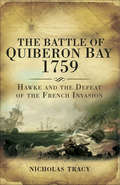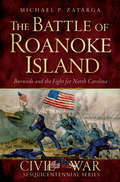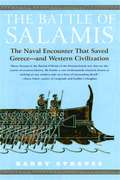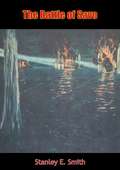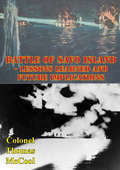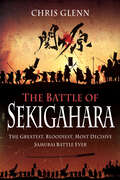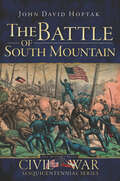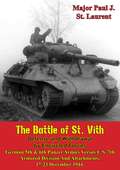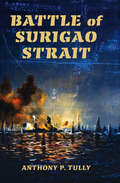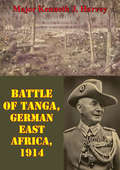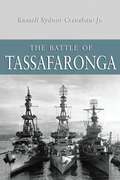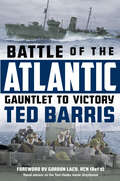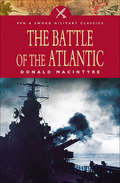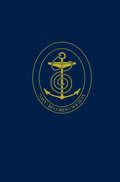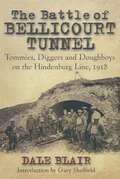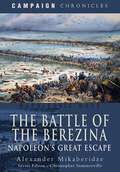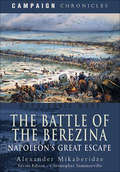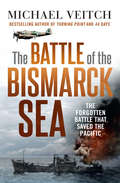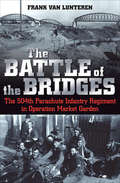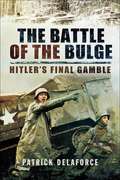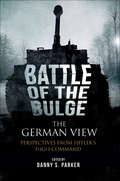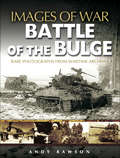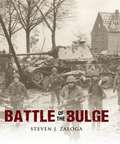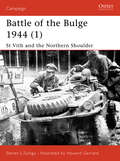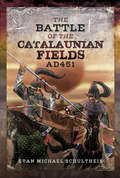- Table View
- List View
The Battle of Quiberon Bay, 1759: Hawke and the Defeat of the French Invasion
by Nicholas TracyRevered naval theorist, Alfred Thayer Mahan, thought the Battle of Quiberon Bay (20 Nov 1759) was as significant as Nelson's victory in 1805, calling it 'the Trafalgar of this war [the Seven Years War]'. Arguably it was even more vital. Britain in 1759 was much less well-defended, with virtually no regular troops at home, and the threat of French invasion was both more realistic and more imminent. When the British fleet under Admiral Hawke fell upon them, the French ships of the line under Admiral Conflans were actually on their way to rendezvous with the invasion troopships gathered at the mouth of the Loire. Yet the battle and the admiral remain relatively obscure—there is no Quiberon Square or Hawke's column. The battle itself was fought in terrible weather, the French attempting to exploit their local knowledge by heading for Quiberon Bay, assuming the British would not follow them among its treacherous shoals in such conditions. Hawke, however, pursued them under full sail and the French ships were destroyed, captured, run aground or scattered for the loss of only two British ships which ran aground. The invasion was thwarted. Professor Nicholas Tracy studies the battle and its strategic consequences, particularly upon the war for North America.
Battle of Roanoke Island, The: Burnside and the Fight for North Carolina (Civil War Series)
by Michael P. ZatargaIn the winter of 1861, Union armies had failed to win any significant victories over their Confederate counterparts. The Northern populace, overwhelmed by the bloodshed, questioned whether the costs of the war were too high. President Lincoln despondently wondered if he was going to lose the Union. As a result, tension was incredibly high when Union hero Ambrose Burnside embarked for coastal North Carolina. With the eyes of the nation and world on little Roanoke Island in the Outer Banks, Burnside began his amphibious assault on the beaches and earned a victory that shifted control of Southern waters. Join author and historian Michael Zatarga as he traces the story of the crucial fight on Roanoke Island.
The Battle of Salamis: The Naval Encounter That Saved Greece and Western Civilization
by Barry StraussOn a late September day in 480 B.C., Greek warships faced an invading Persian armada in the narrow Salamis Straits in the most important naval battle of the ancient world. Overwhelmingly outnumbered by the enemy, the Greeks triumphed through a combination of strategy and deception. More than two millennia after it occurred, the clash between the Greeks and Persians at Salamis remains one of the most tactically brilliant battles ever fought. The Greek victory changed the course of western history -- halting the advance of the Persian Empire and setting the stage for the Golden Age of Athens. In this dramatic new narrative account, historian and classicist Barry Strauss brings this landmark battle to life. He introduces us to the unforgettable characters whose decisions altered history: Themistocles, Athens' great leader (and admiral of its fleet), who devised the ingenious strategy that effectively destroyed the Persian navy in one day; Xerxes, the Persian king who fought bravely but who ultimately did not understand the sea; Aeschylus, the playwright who served in the battle and later wrote about it; and Artemisia, the only woman commander known from antiquity, who turned defeat into personal triumph. Filled with the sights, sounds, and scent of battle, The Battle of Salamis is a stirring work of history.
The Battle of Savo
by Stanley E. SmithNight of Confusion…Down the “Slot”—that fabled channel between chains of islands in the Solomon group—steamed the task force of Admiral Gunichi Mikawa, Japanese Imperial Navy.His target: the Allied cruiser group gathered off Savo Island, near Guadalcanal.Three thousand Japanese guns were pointed at the destroyer Blue, on interception duty at the head of the Allied column. But no one aboard Blue noticed the enemy force churning past—so Blue roused no enemy fire.Not so lucky were the cruisers Quincy, Vincennes, Canberra and Astoria. This exciting factual book details the incredible confusion and horror that made the Battle of Savo a low point in American naval history.An American Naval TragedySo shocking was the defeat of American naval forces by the Japanese in Savo Sound, that the American public could not accept the true story until ten years afterward.On Guadalcanal, Marines were moving up the rugged Tenaru River country, ranging for battle and depending on the Navy for cover.On board the flagship McCawley, Admiral Turner was begging for carrier-based air support that never came.On the flag bridge of his heavy cruiser, Chokai, Admiral Gunichi Mikawa signalled the torpedo fire that opened “The Battle of Savo”.
Battle Of Savo Island - Lessons Learned And Future Implications
by Colonel Thomas MccoolAs the United States enters into the 21st century, it will face new and different challenges that will be more complex than those encountered in the past. Evolutions in doctrine, training, and equipment modernization, influenced by informational and technological advances, will enhance U.S. ability to accomplish national objectives. Valuable lessons learned can be realized by studying past operations that failed to understand the threat and capitalize on friendly capabilities. The Battle of Savo Island in August 1942 is one such event. This short but violent naval engagement, a daring Japanese night surface attack conducted at the beginning of the Guadalcanal campaign on 9 August 1942, was a significant tactical victory for the Imperial Japanese Fleet and has been called the worst blue water defeat in the U.S. Navy's history. This paper will address the shortcomings at Savo Island, particularly in terms of intelligence, command and control, training, force protection, and leadership and discuss these concepts as they apply to current and future operations in the 21st century.
The Battle of Sekigahara: The Greatest, Bloodiest, Most Decisive Samurai Battle Ever
by Chris GlennSekigahara was the greatest samurai battle in history. Japan had long been at civil war until brought under the rule of Oda Nobunaga, and then, following his death at the hands of a traitorous general, that of Toyotomi Hideyoshi. It was Hideyoshi who completed the unification of Japan and ushered in a period of peace. After Hideyoshi’s death in 1598, a power struggle emerged between those loyal to the Toyotomi, and those who supported the second most powerful warlord, Tokugawa Ieyasu. With Hideyoshi gone, Ieyasu made moves that brought the ire of a number of his contemporaries, and soon the entire country was divided into two great armies, East and West. Leading the loyalist cause was Ishida Mitsunari, who gathered a force of around 130,000 samurai, while the Tokugawa commanded just 80,000. Both sides hurried to seize strategically vital highways and castles. These attacks and sieges culminated in the decisive Battle of Sekigahara. Fought on 21 October 1600, the battle lasted just six hours, but saw the deaths of an estimated 30,000 samurai, the destruction of a number of noble families and the creation of the Tokugawa Shogunate that was to rule Japan for 260 years of relative peace. The loyalist forces, despite their superior numbers and excellent battle formations, were defeated. In his exploration of the battle, Chris Glenn reveals the developments that led up to the outbreak of war, the characters involved, how the battle itself unfolded, and the aftermath. The weapons and armor of the time are also fully explained, along with little known customs of the samurai and their warfare.
The Battle of South Mountain (Civil War Series)
by John David Koptak&“A thorough account of the fighting . . . Not only appealingly written but a worthwhile addition to Maryland Campaign literature.&” —Historynet.com In September 1862, Robert E. Lee led the Army of Northern Virginia north of the Potomac River for the time as part of his Northern invasion, seeking a quick end to the war. Lee divided his army in three, sending General James Longstreet north to Hagerstown and Stonewall Jackson south to Harper&’s Ferry. It was at three mountain passes, referred to as South Mountain, that Lee&’s army met the Federal forces commanded by General George B. McClellan on September 14. In a fierce day-long battle spread out across miles of rugged, mountainous terrain, McClellan defeated Lee but the Confederates did tie up the Federals long enough to allow Jackson&’s conquest of Harper&’s Ferry. Join historian John Hoptak as he narrates the critical Battle of South Mountain, long overshadowed by the Battle of Antietam. &“A remarkable work . . . The marches of both armies to South Mountain are presented with close attention to the men in the ranks. The combat is fully covered at each of the gaps in South Mountain.&” —Civil War Librarian &“A crisp, concise but comprehensive account of the battles at the four passes or &‘gaps&’ across South Mountain on September 14, 1862 . . . A truly scholarly effort that will satisfy both serious Civil War students and the general reading public. For Maryland Campaign aficionados, it is a must have addition to your library and is now the definitive account of the battle.&” —South from the North Woods
The Battle of St. Vith, Defense and Withdrawal by Encircled Forces: German 5th & 6th Panzer Armies Versus U.S. 7th Armored Division and Attachments, 17-23 December 1944
by Major Paul J. St. LaurentWhen the German Ardennes Offensive of December 1944 ruptured the front of the U.S. First Army, Major General Troy Middleton committed his VIII Corps to the defense of selected transportation bottlenecks in the path of the German advance. St. Vith, located in the central sector of the Ardennes battleground, was one of these. Although by passed by German spearheads bound for the Meuse River, the 7th Armored Division (plus major elements of three other divisions) held the position against major elements of two German Panzer armies. After six days of tenacious defense while practically encircled, the St. Vith force was ordered to withdraw. The defenders of St. Vith prevented the Germans from effectively supplying their armored spearheads, drew off their follow-on forces, and bought time for the U.S. First Army to consolidate its position on the north flank of the German penetration.
Battle of Surigao Strait (Twentieth-Century Battles)
by Anthony P. TullySurigao Strait in the Philippine Islands was the scene of a major battleship duel during the Battle of Leyte Gulf. Because the battle was fought at night and had few survivors on the Japanese side, the events of that naval engagement have been passed down in garbled accounts. Anthony P. Tully pulls together all of the existing documentary material, including newly discovered accounts and a careful analysis of U.S. Navy action reports, to create a new and more detailed description of the action. In several respects, Tully's narrative differs radically from the received versions and represents an important historical corrective. Also included in the book are a number of previously unpublished photographs and charts that bring a fresh perspective to the battle.
Battle Of Tanga, German East Africa, 1914
by Major Kenneth J. HarveyIn November 1914, British Indian Expeditionary Force "B" conducted an amphibious assault on the Port of Tanga in German East Africa. The British possessed all the tools required for success; they outnumbered the defenders almost eight to one, they possessed the only artillery and naval guns available for the battle, and they landed where the Germans were weak. Despite these factors, a hastily organized German defense force of 1,100 soldiers not only defeated the 8,000 British soldiers, but also compelled Indian Expeditionary Force "B" to retreat to Mombasa.This thesis examines the manner in which German and British forces were organized, trained, equipped, and led. Additionally, it identifies the critical factors that together led to British defeat at Tanga.
The Battle of Tassafaronga
by Russell Crenshaw Jr.The Battle of Tassafaronga, November 30, 1942, was the fifth and last major night surface action fought off Savo Island during World War II s Guadalcanal campaign. It ended a string of Japanese victories, but it was also a horrible embarrassment to the U.S. Navy, which had three heavy cruisers damaged and one sunk to enemy torpedoes. After the battle, American commanders erroneously reported that multiple enemy ships had been sunk or seriously damaged, leading Admiral Nimitz to focus on training as the missing ingredient. Not until more than half a century later did Captain Russell S. Crenshaw, Jr., the destroyer Maury s gunnery officer during the battle, discover that the outcome hinged instead on critical shortcomings that had been built into the U.S. Navy before the war defective torpedoes, poor intelligence, blinding gunfire, over-confidence, and a tendency to equate volume of fire with effectiveness of fire factors that turned the battle into a crucible in which the very nature of the U.S. Navy and its weapons was tested [and] a miniature of what might have been, under other circumstances, a truly devastating defeat.
Battle of the Atlantic: Gauntlet to Victory
by Ted BarrisThe Battle of the Atlantic, Canada’s longest continuous military engagement of the Second World War, lasted 2,074 days, claiming the lives of more than 4,000 men and women in the Royal Canadian Navy, the Royal Canadian Air Force and the Canadian merchant navy The years 2019 to 2025 mark the eightieth anniversary of the longest battle of the Second World War, the Battle of the Atlantic. It also proved to be the war’s most critical and dramatic battle of attrition. For five and a half years, German surface warships and submarines attempted to destroy Allied trans-Atlantic convoys, most of which were escorted by Royal Canadian destroyers and corvettes, as well as aircraft of the Royal Canadian Air Force. Throwing deadly U-boat “wolf packs” in the paths of the convoys, the German Kriegsmarine almost succeeded in cutting off this vital lifeline to a beleaguered Great Britain.In 1939, the Royal Canadian Navy went to war with exactly thirteen warships and about 3,500 regular servicemen and reservists. During the desperate days and nights of the Battle of the Atlantic, the RCN grew to 400 fighting ships and over 100,000 men and women in uniform. By V-E Day in 1945, it had become the fourth largest navy in the world. The story of Canada’s naval awakening from the dark, bloody winters of 1939–1942, to be “ready, aye, ready” to challenge the U-boats and drive them to defeat, is a Canadian wartime saga for the ages. While Canadians think of the Great War battle of Vimy Ridge as the country’s coming of age, it was the Battle of the Atlantic that proved Canada’s gauntlet to victory and a nation-building milestone.
The Battle of the Atlantic: Fighting The U-boats In The Battle Of The Atlantic (Sven Hassel War Classics)
by Donald MacintyreAn eyewitness account of the fight for supremacy at sea during World War II, as told by a man who was in the thick of combat against Nazi Germany. The Battle of the Atlantic was an unremitting assault by enemy boats and aircraft against Allied merchant ships that were the lifeline of Great Britain—and the vigilant defense against them made by the Royal Navy and other allied forces. Captain Donald Macintyre—a winner of the Distinguished Service Cross who participated in the fighting, escorting over 1,100 ships and losing only two—tells the story with immediacy and clarity. He describes the measures employed to defeat the amazingly successful ‘wolf-pack’ tactics of the U-boats, the convoy system and individual convoys, never shirking from how desperately close to defeat the Allies were at times. Not only does he analyze the strategic issues of the day, he also describes the battle from the viewpoint of the participants themselves. The long, drawn-out duels between escort and U-boat are made vivid by quotations from the log-books of some of the ablest escort-commanders as well as combat reports of the German U-boat captains. Featuring dozens of rare wartime photographs drawn from both German and British sources, this account of the sacrifice and savagery of war makes the courage and endurance of those who fought in the Atlantic all the more palpable.
The Battle of the Atlantic and Signals Intelligence: U–Boat Situations and Trends, 1941–1945
by David SyrettThis title was first published in 2002. This book contains the U-boats situations and trends written by the staff of the Admiralty’s Operational Intelligence Centre during the Second World War. Based largely on communications intelligence, the U-boat situations and trends were designed to inform a small number of senior officers and high officials of the latest events and developments in the Allied war against the U-boats. The Battle of the Atlantic and the war against the U-boats was the longest and the most complex naval battle in history. In this huge conflict which sprawled across the oceans of the world the U-boats sank 2,828 Allied merchant ships while the Allies destroyed more than 780 German U-boats. These documents relate on a weekly, and in some cases a daily, basis exactly what the Allies knew concerning the activities of the U-boats during the Battle of the Atlantic.
The Battle of the Bellicourt Tunnel: Tommies, Diggers and Doughboys on the Hindenburg Line, 1918
by Dale BlairIn the summer and autumn of 1918, the British Expeditionary Force, under Field Marshal Haig, fought a series of victorious battles on the Western Front that contributed mightily to the German Army’s final defeat. They did so as part of an Allied coalition, one in which the role of Australian diggers and US doughboys is often forgotten. The Bellicourt Tunnel attack in September 1918, fought in the fading autumn light, was very much an inter-Allied affair and marked a unique moment in the Allied armies’ endeavors. It was the first time that such a large cohort of Americans had fought in a British formation. Additionally, untried American II Corps and experienced Australian Corps were to spearhead the attack under the command of Lieutenant General Sir John Monash, with British divisions adopting supporting roles on the flanks. Blair forensically details the fighting and the largely forgotten desperate German defenxe. Although celebrated as a marvelous feat of breaking the Hindenburg Line, the American attack generally failed to achieve its set objectives and it took the Australians three days of bitter fighting to reach theirs. Blair rejects the conventional explanation of the US mop up failure and points the finger of blame at Rawlinson, Haig and Monash for expecting too much of the raw US troops, singling out the Australian Corps commander for particular criticism. Overall, Blair judges the fighting a draw. At the end, like two boxers, the Australian-American force was gasping for breath and the Germans, badly battered, were backpedalling to remain on balance. That said, the day was calamitous for the German Army, even if the clean breakthrough that Haig had hoped for did not occur. Forced out of the Hindenburg Line, the prognosis for the German army on the Western Front and hence Imperial Germany itself was bleak indeed.
The Battle of the Berezina: Napoleon's Great Escape (Campaign Chronicles)
by Alexander MikaberidzeThe full story of Napoleon&’s legendary escape from Russia under seemingly impossible odds is recounted in this thrillingly vivid military history. In the winter of 1812, Napoleon's army retreated from Moscow under appalling conditions, hunted by three separate Russian armies. By late November, Napoleon had reached the banks of the River Berezina—the last natural obstacle between his army and the safety of the Polish frontier. But instead of finding the river frozen solid enough to march his men across, an unseasonable thaw had turned the Berezina into an icy torrent. Having already ordered the burning of his bridging equipment, Napoleon's predicament was serious enough: but with the army of Admiral Chichagov holding the opposite bank, and those of Kutusov and Wittgenstein closing fast, it was critical. In a gripping narrative that draws on contemporary sources—including letters, diaries and memoirs—Alexander Mikaberidze describes how Napoleon rose from the pit of despair to execute one of the greatest escapes in military history.
The Battle of the Berezina: Napoleon's Great Escape (Campaign Chronicles)
by Alexander MikaberidzeThe full story of Napoleon&’s legendary escape from Russia under seemingly impossible odds is recounted in this thrillingly vivid military history. In the winter of 1812, Napoleon's army retreated from Moscow under appalling conditions, hunted by three separate Russian armies. By late November, Napoleon had reached the banks of the River Berezina—the last natural obstacle between his army and the safety of the Polish frontier. But instead of finding the river frozen solid enough to march his men across, an unseasonable thaw had turned the Berezina into an icy torrent. Having already ordered the burning of his bridging equipment, Napoleon's predicament was serious enough: but with the army of Admiral Chichagov holding the opposite bank, and those of Kutusov and Wittgenstein closing fast, it was critical. In a gripping narrative that draws on contemporary sources—including letters, diaries and memoirs—Alexander Mikaberidze describes how Napoleon rose from the pit of despair to execute one of the greatest escapes in military history.
The Battle of the Bismarck Sea
by Michael VeitchIn the thick of World War II, during the first week of March 1943, Japan made a final, desperate lunge for control of the South West Pacific. In the ensuing Battle of the Bismarck Sea, a force of land-based Australian and American planes attacked a massive convoy of Japanese warships. The odds were against them. But a devastating victory was won and Japan's hopes of regaining the initiative in New Guinea destroyed. More importantly for Australians, the victory decisively removed any possibility that Australia might be invaded by Japanese forces. It was, for us, one of the most significant times in our history - a week when our future was profoundly in the balance. Bestselling author Michael Veitch tells the riveting story of this crucial moment in history - how the bravery of young men and experienced fighters, renegades and rule-followers, overcame some of the darkest days of World War II.
The Battle of the Bridges: The 504th Parachute Infantry Regiment in Operation Market Garden
by Frank van Lunteren&“On these pages, the human story comes to life, sometimes tragic, sometimes amusing, but always poignant and compelling&” (John C. McManus, author of Fire and Fortitude). Operation Market Garden has been recorded as a complete Allied failure in World War II, an overreach that resulted in an entire airborne division being destroyed at its apex. However, within that operation were episodes of heroism that still remain unsung. On September, 17, 1944, the 504th Parachute Infantry Regiment, 82nd Airborne Division, floated down across the Dutch countryside, in the midst of German forces, and proceeded to fight their way to vital bridges to enable the Allied offensive to go forward. The 101st Airborne was behind them; the British 1st Airborne was far advanced. In the 82nd&’s sector, the crucial conduits needed to be seized. The Germans were as aware of the importance of the bridge over the Waal River at Nijmegen as James Gavin and his 82nd troopers were. Thus began a desperate fight for the Americans to seize it, no matter what the cost. The Germans would not give up, however, and fought tenaciously in the town and fortified the bridge. On September 20, Gavin turned his paratroopers into sailors and conducted a deadly daylight amphibious assault in small plywood and canvas craft across the Waal River to secure the north end of the highway bridge in Nijmegen. German machine guns and mortars boiled the water on the crossing, but somehow, a number of paratroopers made it to the far bank. Their ferocity rolled up the German defenses, and by the end of the day, the bridge had fallen. This book by Dutch historian Frank van Lunteren draws on a plethora of previously unpublished sources to shed new light on the exploits of the &“Devils in Baggy Pants.&” A native of Arnhem—the site of the &“Bridge Too Far&”—the author draws on nearly 130 interviews he personally conducted with veterans of the 504th, plus Dutch civilians and British and German soldiers, who here tell their story for the first time.
The Battle of the Bulge: Hitler's Final Gamble
by Patrick DelaforceBy late 1944 the Allies were poised to smash the Siegfried Line and break into Germany. Supply lines were shorter thanks to the port of Antwerp. Arnhem aside, there had been a long run of victories and there was no intelligence even from ULTRA to suggest a German counter-offensive.So the major December attack through the mountainous Ardennes by massed Panzers and infantry took the Allies totally by surprise. Fog and low cloud negated the Allies' air supremacy, English-speaking German commandos in captured jeeps created panic and withdrawal of US forces became a near rout with morale all but broken.For ten days the situation worsened and Antwerp was seriously threatened and 21st Army Group in danger of being cut off.Clear skies for the Thunderbolts and coherent counter-attacks by rapidly deployed reinforcements turned the tide in the nick of time, so preventing a catastrophic defeat for the Allies.All this and more is graphically narrated in this fine study of a pivotal battle, that so nearly changed the course of war.
The Battle of the Bulge: Perspectives from Hitlers High Command
by Danny S. ParkerAs Allied armies swept towards the Reich in late 1944, the German high command embarked on an ambitious plan to wrest the initiative on the Western Front and deal a crippling blow to the Allied war effort. This superb book brings together a wealth of primary source material - including German documentation and debriefs of German generals - to tell the story of this famous campaign from the German point of view. Expertly edited by the acclaimed historian Danny S. Parker, this is an impressive volume which sheds fascinating light on one of the most crucial episodes of the Second World War.
Battle of the Bulge: Rare Photogaphs from Wartime Archives (Images of War)
by Andy RawsonDramatic photographs of Nazi Germany’s shocking Ardennes Offensive that nearly turned the tide of World War II—from the author of In Pursuit of Hitler.Hitler’s desperate last throw during the depths of winter 1944/45 came perilously close to being a major disaster for the Allies. Their offensive through the Ardennes fell on the Americans and caught them totally by surprise. Unaccustomed to setbacks, the situation was for a time extremely serious and in some areas panic set in and events went out of control. It was only after the most bitter fighting and massive reinforcement that the rot was stopped. In this book the drama of those worrying weeks is captured in superb photographs.
Battle of the Bulge
by Steven J. ZalogaThe Battle of the Bulge was the last major German offensive in the West and the largest and the most costly battle fought by the US Army in World War II. Fought during the bitter winter of 1944-45, and resulting in over 100,000 German casualties and over 80,000 American casualties, it turned an apparent defeat into what British Prime Minister Winston Churchill called 'an ever-famous American victory'. Three armies attacked through the Ardennes, the weakest point in the American lines - and almost broke through. At St Vith and Elsenborn Ridge, Hitler, gambling everything in the hope that the residual might of the German army would not only force a breakthrough but would also split the Allied coalition in two, concentrated the bulk of his Panzer forces in the form of the Sixth Panzer Army. When the German advance here failed, Hitler switched the focus of the offensive to General Manteuffel's 5th Panzer Army in the south. Heavily attacked by superior German armor, outnumbered and without air support, the US army was on its own. The green US 106th Division held its own for a time, but then gave way in the biggest US surrender since Kasserine. German Panzers flooded towards the River Meuse. But at Bastogne their way was barred by the paratroopers of the 101st Airborne, the "Screaming Eagles". The ensuing battle of Bastogne would prove to be one of the most decisive battles of the war. In spite of its ultimate German failure, the Battle of the Bulge would have an important effect on the War and its aftermath: it slowed the Allies down, resulting in more territory being ceded to the Russian sphere of influence at the end of the War. This book on the decisive campaign of the war in northwest Europe provides a full account of the campaign strategy; the American and German forces and command; their equipment and tanks; and a detailed account of the fighting.
Battle of the Bulge 1944: 115
by Howard Gerrard Steven ZalogaOsprey's first title examining the Battle of the Bulge, which was the largest and most costly battle fought by the US Army in World War II (1939-1945). The Ardennes fighting was Hitler's last gamble on the Western Front, crippling the Wehrmacht for the remainder of the war. In the first of two volumes on the Ardennes campaign Steven Zaloga details the fighting in the northern sector around St Vith and the Elsenborn Ridge. Sixth Panzer Army, containing the bulk of German Panzer strength, was expected to achieve the breakthrough here. It was the failure around St Vith that forced the Germans to look south towards Bastogne.
The Battle of the Catalaunian Fields AD 451: Flavius Aetius, Attila the Hun and the Transformation of Gaul
by Evan Michael SchultheisA reassessment of the famous fifth-century clash between Hun and Roman forces: &“An excellent job of research with original documents.&” —The Past in Review This book reconsiders the evidence for Attila the Hun&’s most famous battle, the climax of his invasion of the Western Roman Empire that had reached as far as Orleans in France. Traditionally considered one of the pivotal battles in European history, saving the West from conquest by the Huns, the Catalaunian Fields is here revealed to be significant but less immediately decisive than claimed. This new study exposes oversimplified views of Attila&’s army, which was a sophisticated and complex all-arms force, drawn from the Huns and their many allies and subjects. The &‘Roman&’ forces, largely consisting of Visigoth and Alan allies, are also analyzed in detail. The author, a reenactor of the period, describes the motives and tactics of both sides. Drawing on the latest historiography and research of the primary sources, and utilizing Roman military manuals, Evan Schultheis offers a completely new tactical analysis of the battle and a drastic reconsideration of Hun warfare, the Roman use of federates, and the ethnography of the Germanic peoples who fought for either side. The result is a fresh and thorough case study of battle in the fifth century. Includes maps and illustrations
